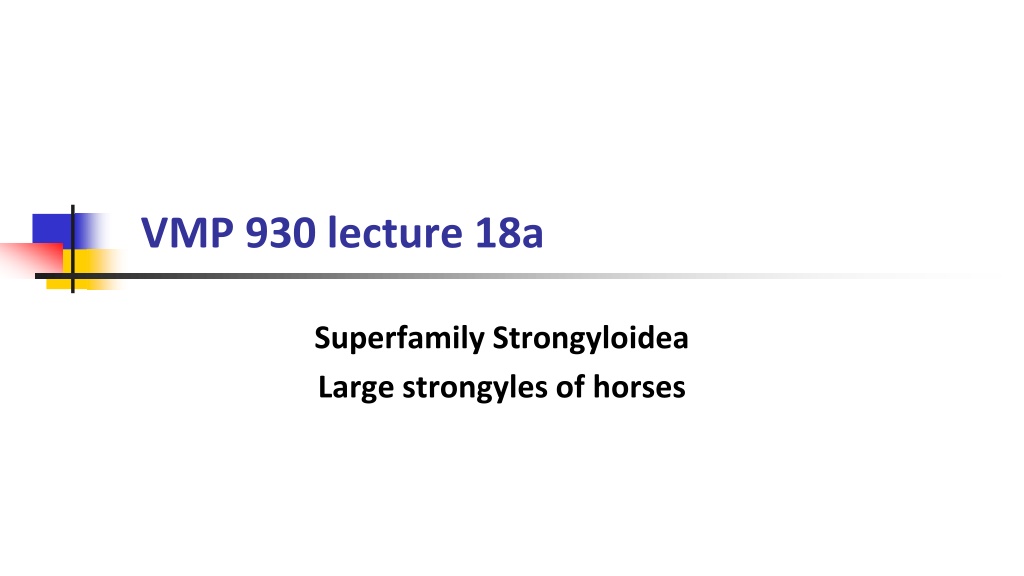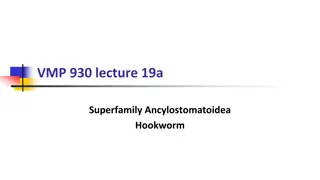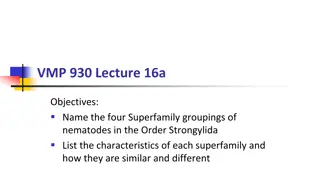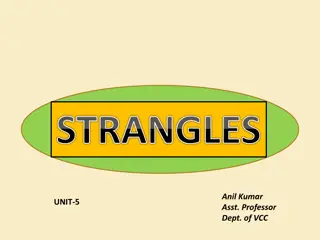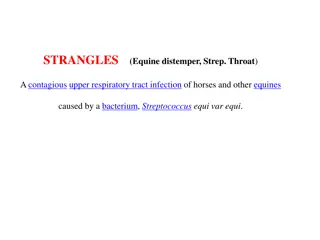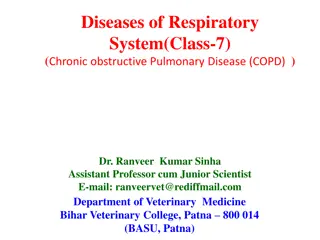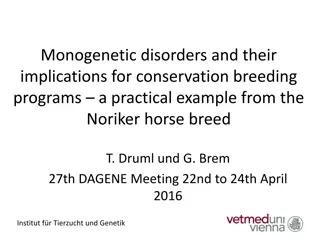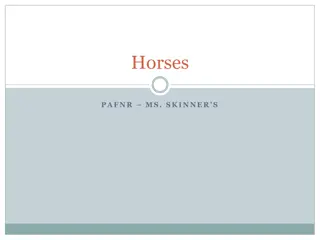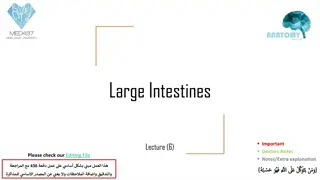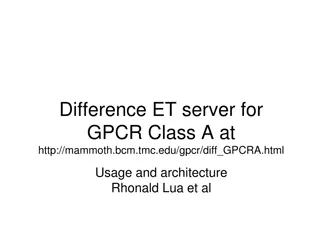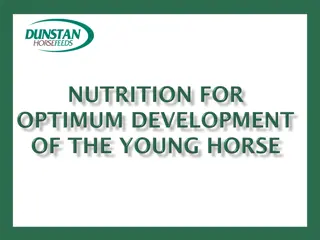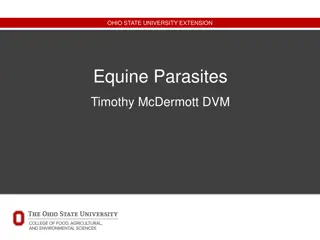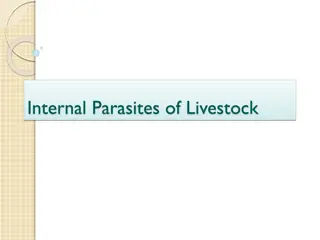Understanding Large Strongyles in Horses: Superfamily Strongyloidea
Explore the world of large strongyles in horses, specifically focusing on the Superfamily Strongyloidea. Discover key features of strongyle morphology, their presence in different animals, and detailed insights into species like Strongylus vulgaris. Learn about the life-cycle, prepatent periods, and effective control measures against these parasites.
Download Presentation

Please find below an Image/Link to download the presentation.
The content on the website is provided AS IS for your information and personal use only. It may not be sold, licensed, or shared on other websites without obtaining consent from the author. Download presentation by click this link. If you encounter any issues during the download, it is possible that the publisher has removed the file from their server.
E N D
Presentation Transcript
VMP 930 lecture 18a Superfamily Strongyloidea Large strongyles of horses
Order STRONGYLIDA Superfamilies: Trichostrongyloidea Strongyloidea Metastrongyloidea = infect lungs Ancylostomatoidea
Superfamily STRONGYLOIDEA Horses -- strongyles of large intestine Ruminants -- nodular worms of large intestine Swine -- kidney worms and nodular worms Birds -- tracheal gapeworms
Strongyle Morphology large, thick body large buccal cavity leaf crown teeth (+/-)
Strongyle Morphology Male worm Copulator bursa is well-developed
Strongyles in Horses LARGE and SMALL strongyles in large intestine
Large intestine mucosal surface large strongyle small strongyles large strongyle
Superfamily Strongyloidea in Horses Strongylus species (large strongyles) S. vulgaris S. edentatus S. equinus Triodontophorus species Cyathostomes (small strongyles)
Strongylus vulgaris: Life-cycle L3 ingested when horse is grazing on infected pasture (only route of infection). (Just like trichostrongyles in ruminants.) larva penetrates intestinal wall (~1-7 days) Larva migrates in vessel wall up to the cranial mesenteric artery or aorta taking 8-21 days L4 break into blood stream and carried back to colon & cecum, develop to adult stage during 2-4 months total prepatent period ~6 months
Prepatent periods of large strongyles Large strongyles are easily controlled and not found often. Why? Remember these strongyles do not arrest, and no hypobiosis. Current drugs are effective against all stages. Hint: how often would you need to treat to prevent patency?
Strongylus vulgaris: Signs/Pathology Acute disease fever, depression, colic, diarrhea/constipation due to infarction/obstruction of arteries and inflammation from entering larvae soon after turnout Chronic disease Episodes of colic, with/without sudden death Sudden death from thromboemboli and/or rupture of an aortal aneurism
Infarction Ischemia
aorta aorta Cranial mesenteric artery Cranial mesenteric artery Aneurism of cranial mesenteric artery Hypertrophy of arterial walls Felt on rectal palpation
Pathology COLIC: blood flow disrupted thrombo-embolism mechanical damage to intestine altered motility allergic irritation innervation abnormalities
Pathology Blood chemistry: Eosinophilia Hypergammaglobulinemia hypoalbuminemia, esp. with migratory larvae
Diagnosis Eggs in feces, but same type as small strongyles ...BUT IF.....clinical signs are positive and fecal is negative What s your explanation?
VMP 930 lecture 18b Superfamily Strongyloidea Small strongyles of horses
Cyathostomes = small strongyles This nematode is the target of routine deworming of horses on pasture. World-wide cost of control (not cure) of cyathostome infections in horses is very large.
Cyathostomes, the small strongyles >40 species in large intestine of horses also species specific to elephants, pigs, marsupials, turtles distinct buccal capsules 'smaller' than the large strongyles, ~15 mm
Cyathostomes larvae do NOT migrate beyond large intestine L4 can arrest in intestinal mucosa and reactivate at later times, especially when horse is stressed or in springtime/foaling season or after removal of adult worms by deworming. prepatent period is ~ 2.5 - 3 months without arrest
Cyathostomes granulomatous colitis from larvae in mucosa major loss of protein, not blood, edema Massive numbers of emerging larvae Progressive emaciation emerging larvae=colitis+diarrhea
Cyathostomes Control: All ages of horses can be sources of pasture contamination Arrested larval forms are not easily killed by many drugs Adult worm drug resistant strains have evolved Steroid therapy in face of clinical signs
Treatment & Control pasture management remove manure; keep grass short avoid mixing foals with yearlings (Why?) monitor fecal egg counts (McMasters) on individual horses as a basis for selective deworming at 3 years of age and older.
Control program against strongyles deworming schedule - strategic during grazing season with larvicidal drug at beginning and end of grazing period use a larvicidal drug q 6 months to kill emerging and arrested L4s e.g. fenbendazole elevated/prolonged dosage, or moxidectin Any drug that kills metabolically active larvae will kill adults
Eggs per Gram (EPG) Strongyle-type eggs Genus?? Variability in results: technique is important 20% of individuals in herd produce 80% of eggs deposited on pasture. Justification for selective deworming . Interpretation of data for tactical (response to the current situation) treatment. Horses: >200 -500 epg
EPG tells you the horse is Infected with mature strongyle adult worms; probably also has larval stages in mucosa. But low or negative epg does not rule out mucosal larval stages that may be causing disease. Adult worms are contaminating the pasture with eggs (which will become infective larvae)
So, whats a good deworming schedule for horses?!!! See American Association of Equine Practitioners Guidelines 2016. (Summary in your lecture manual.) First year: (foals, weanlings, yearlings) deworm at least 4 times starting at 2-3 months of age again at 4-6 months old, 9 months and 12 months if on pasture. >3 years old: two treatments at six-month interval minimum for small strongyles (also covers large strongyles, tapeworms, bots and stomach worms). Do fecal egg counts to adjust treatment frequency upward on individual basis.
Some common dewormers: (FYI only) Pyrantel STRONGID-C (Pellets; tartrate salt; daily) STRONGID-T (Paste; pamoate salt) Fenbendazole PANACUR Ivermectin EQVALAN paste/liquid, DURAMECTIN, ZIMECTIN (with praziquantel) Moxidectin QUEST GEL Abamectin/Praziquantel EQUIMAX
VMP 930 lecture 18c Superfamily Strongyloidea Oesophagostomum (nodular worm) Syngamus trachea (gape worm)
Oesophagostomum spp. There are many species of Oesophagostomum Most species are host specific
Oesophagostomum cephalic collar NODULAR worm of cattle, sheep, goats, swine and primates Adult worms: in large intestine 15-20 mm long, stout cephalic collar at anterior end
Oesophagostomum L3s are ingested while grazing Larvae are within encapsulated cysts (aka Nodules) in both large and small intestine. Serosal view of cystic nodule response to larvae
Oesophagostomum Pathogenesis due mostly to larvae adhesions, calcified cysts Enteritis/diarrhea when L4s emerge i.e. acute inflammatory reaction Mucosal view of response to emerging larvae
Oesophagostomum in Swine Ingestion of infective larvae Much transmission of infection to piglets due to peak worm-egg production in sow at ~6 weeks after farrowing
Syngamus trachea (FYI only) aka gapeworm permanent copula Avian host turkey, pheasants, fowl, captive emus in NC 2-20 mm long adults, in permanent copula Unlike other genera in the Strongyloidea superfamily this worm has double operculated ova. small male large female
Syngamus trachea (FYI only) Life-cycle opercula direct ingestion of egg OR via a transport host (earthworm, snail, slug) After ingestion larvae migrate into the airways and mature in lungs PPP ~3 weeks eggs are coughed up and swallowed bi-operculated egg in feces Birds show signs of tracheal obstruction
VMP 930 lecture 18d Superfamily Metastrongyloidea Metastrongylus in pigs Aelurostrongylus abstrusus in cats
Order Strongylida Superfamilies: Trichostrongyloidea Strongyloidea Metastrongyloidea = infect lungs Ancylostomatoidea
Metastrongyles Metastrongyles Mostly respiratory system but some affect the vascular and nervous systems. None enteric Life-cycle can be: INDIRECT requiring snails, slugs, earthworms Direct (Filaroides sp. not covered here)
Metastrongylus (lung worms of swine) 2 trilobed lips adult worms large, white in bronchi larvated eggs are released from the female in the bronchi, coughed up, swallowed and passed out in feces
Aelurostrongylus abstrusus (lung worm of cats) Adults in lung parenchyma of CATS Occasionally seen in N.C. Grayish subpleural nodules
Aelurostrongylus abstrusus Can be the cause of severe disease in indoor/outdoor cats. Diagnosis requires special technique to find motile larvae in feces or sputum.
Aelurostrongylus abstrusus Cat infected by eating infected snail/slug infected paratenic host (e.g. bird) Larvae migrate from stomach to lungs Prepatent period is 5-6 weeks L1 coughed up, swallowed, in feces
Aelurostrongylus abstrusus Pathogenesis Egg masses small, grayish subpleural nodules Adult worms 7-10 mm long Cause smooth muscle hyperplasia and pulmonary hypertrophy Heavy burdens can be fatal
intestine uterus Adult worms in cross-section cuticle Aelurostrongylus abstrusus
Aelurostrongylus abstrusus parenchymal densities Diagnosis Respiratory signs Thoracic radiographs
Aelurostrongylus abstrusus Diagnosis Spine at posterior end L1 larvae in feces or sputum Baermann OR direct smear Baermann funnel
Aelurostrongylus abstrusus Control fenbendazole, ivermectin restrict access to paratenic hosts
